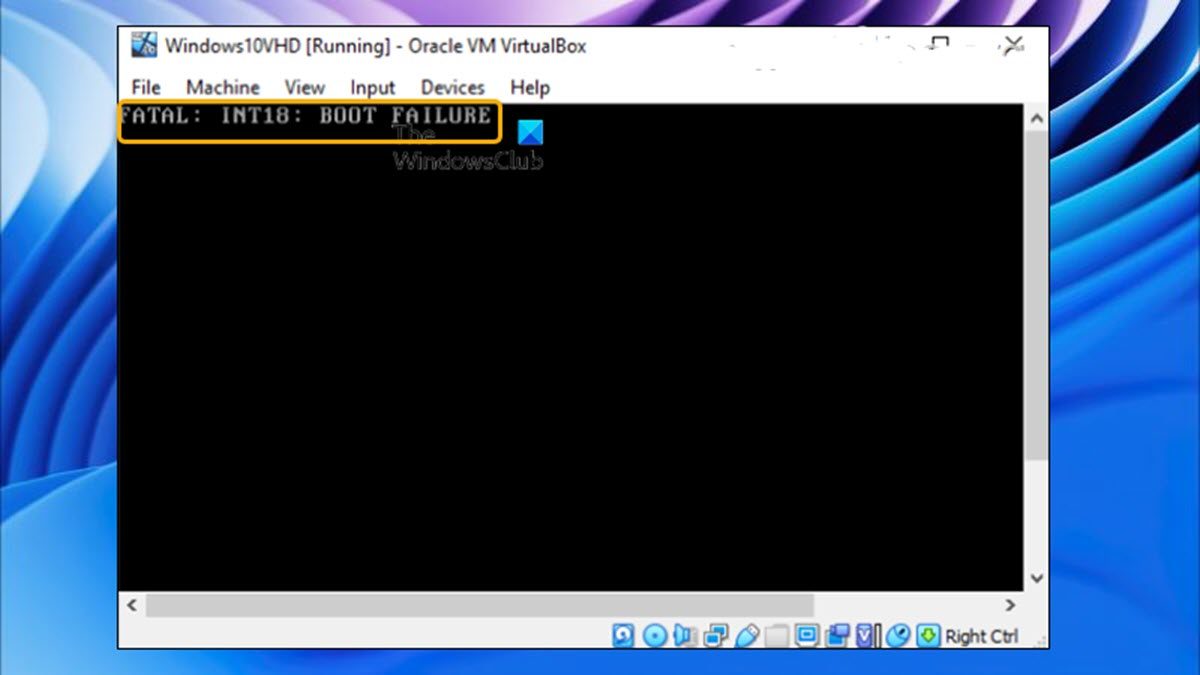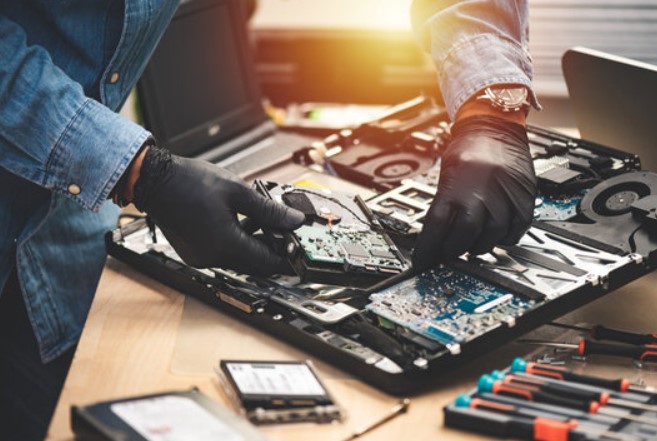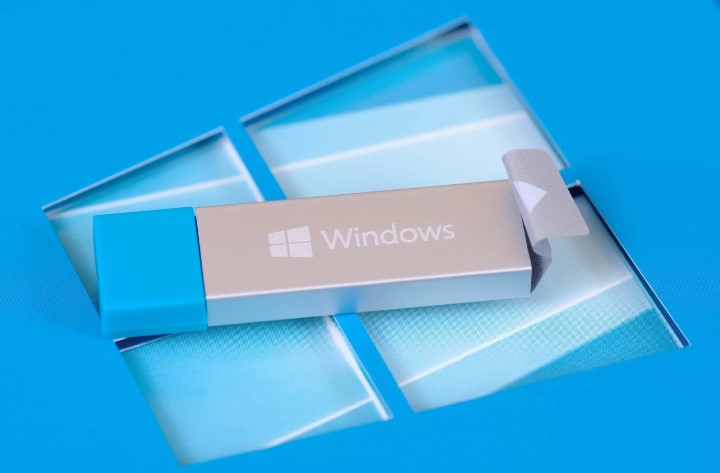VirtualBox FATAL: INT18: BOOT FAILURE Error [Fixed]
![VirtualBox FATAL: INT18: BOOT FAILURE Error [Fixed] VirtualBox FATAL: INT18: BOOT FAILURE Error [Fixed]](https://www.thewindowsclub.com/wp-content/uploads/2022/09/VirtualBox-FATAL-INT18-BOOT-FAILURE-Error.jpeg)
You may get the VirtualBox error FATAL: INT18: BOOT FAILURE when you attempt to start a Windows guest machine on your Windows 11 or Windows 10 host computer. This post offers the most applicable solutions you can try to successfully fix the error on your system.

You may encounter this issue due to one or more of the following reasons.
- it’s an indication the VM file is corrupt.
- Part of the boot sector is inactive.
- The operating system (OS) is unable to boot due to the partition holding the Boot Configuration Data (BCD) Store being inactive.
- The OS is unable to boot due to BCD Corruption.
- The OS is unable to boot due to the boot sector not being found.
Affected users reported the guest operating system running on the VM failed to start after converting the physical disk of a Windows 11/10 UEFI computer to a Virtual Hard disk (VHD or VHDX) and attaching the VHD/VHDX file to a new VirtualBox machine. The error sometimes may throw the error code 0x0000225.
Read: VirtualBox failed to register and open Hard Disk image file
VirtualBox FATAL: INT18: BOOT FAILURE Error
If you have encountered the FATAL: INT18: BOOT FAILURE error when you start a Windows Guest OS in VirtualBox on your host Windows 11/10 machine, you can apply our recommended fixes below to quickly and easily resolve the issue on your system.
- Initial checklist
- Enable I/O APIC & EFI in VirtualBox
- Disable Hyper-V on the Host machine
- Repair the Guest OS
Let’s see these listed suggestions in detail.
Read: VirtualBox VM is not opening or starting in Windows
1] Initial checklist
Before you proceed with the solutions proper below, you first need to verify that the Guest OS partition is Active. This applies only to Generation 1 VMs. Generation 2 VMs (using UEFI) does not use an active partition. To verify the OS partition that holds the BCD store for the disk is marked as active, do the following:
- Open command prompt in elevated mode.
- Open the DISKPART tool.
- In DISKPART, type the command below and hit Enter to list the disks on the system:
list disk
- From the output, look for added disks and input the command below to select the new disk. In this example, the new disk is Disk 1.
sel disk 1
- Next, input the command below and hit Enter to list all of the partitions on the disk:
list partition
- From the output, input the command below and hit Enter to select the partition you want to check. Usually, System Managed partitions are smaller and around 350 Mb in size. In this example, the partition is Partition 1.
sel partition 1
- Next, to check the status of the partition, input the command below and hit Enter:
detail partition
- Now, if the partition isn’t active, input the command below and hit Enter to set the Active flag, and then recheck that the change was done properly with the command above.
active
After you have set the guest OS as an active partition, see if you can start the VM without issues. If the FATAL: INT18: BOOT FAILURE error reoccurs, or this isn’t the case for you as you already have the partition set as active, you can proceed with the next solution.
Read: DiskPart has encountered an error: Access is denied
2] Enable I/O APIC & EFI in VirtualBox
You will encounter this error usually when you are attaching or opening a VHD/VHDX/VMDK file that contains a UEFI operating system. In this case, to resolve the issue, you need to simply enable EFI on the VirtualBox machine’s settings. To perform this task, do the following:
- Press the X button to close the VM machine window and Power Off the machine.
- Next, open the VM Settings.
- Go to System > Motherboard.
- In the Boot Order section, make sure that the Hard Disk is selected and is the first boot device.
- In the Extended Features section, select both the Enable I/O APIC and Enable EFI (special OSes only) options.
- Click OK.
Read: Error 0x80370102 The Virtual machine could not be started because a required feature is not installed
3] Disable Hyper-V on the Host machine
If you have the Hyper-V feature enabled on your system, it could be interfering with the VirtualBox VM starting properly. Hyper-V blocks all other Hyper Visors like VirtualBox from calling VT hardware, therefore it’s required for it to be disabled. So basically, to use other virtualization software on Windows 11/10 host machine, you must disable Hyper-V Hypervisor, Device Guard, and Credential Guard.
To disable Hyper-V on the Host machine, do the following:
- Press the Windows key + R to invoke the Run dialog.
- In the Run dialog box, type
appwiz.cpland hit Enter to open the Programs and Features applet. - In the window, on the left side, click the Turn Windows features on or off link.
- Wait for the applet to populate, then scroll and clear/uncheck the following features:
- Containers
- Hyper-V
- Virtual Machine Platform
- Windows Hypervisor Platform
- Windows Sandbox
- Click OK.
- Restart the computer after uninstalling.
- On boot, open Command Prompt as Administrator.
- In the CMD prompt, type or copy and paste the command below and hit Enter:
bcdedit /set hypervisorlaunchtype off
- Exit CMD prompt once the operation executes.
- Restart computer.
Read: How to enable or disable Nested Virtualization for VMs in Hyper-V
4] Repair the Guest OS
As the guest OS is failing to start, it could be we are dealing with boot problems as the error indicates. In this case, we can attempt to fix boot problems on the Guest machine, by starting the guest machine using Windows 11/10 ISO file and then proceed to run a repair of the guest OS. To perform this task, do the following:
- Download Windows ISO.
- Open the VirtualBox machine Settings.
- Go to Storage.
- Click the 1st plus (+) button next to Controller to add the optical drive.
- Click Add in the Optical Disk Selector window.
- Find and open the Windows.iso file.
- Next, select the Windows.iso file.
- Click Choose.
- After attaching the Windows.iso file in Storage devices, go to System and drag Optical to the top to boot the VM from the attached Windows.iso.
- Next, make sure that the Enable EFI option is not selected, otherwise, you will not be able to boot from the ISO file.
- Click OK when done.
- Next, start the Virtual Machine.
- Click Next > Repair Your computer.
- Select Troubleshoot > Startup Repair.
- Allow the Startup Repair to run and depending on the result do the following actions:
- If Startup Repair completes successfully, shut down the virtual machine, set the hard disk as a first boot device, and try to start again the virtual machine.
- If Startup Repair couldn’t complete the repair, continue to the next step.
- Click Advanced Options > Troubleshoot > Command Prompt.
- In Command prompt, input the following command and hit Enter after each line:
diskpart
select disk 0
list partition
- From the output, make a note of the size of the System partition.
- Next, type the command below and hit Enter to find out the volume number of the System Partition by using its size as a reference.
list volume
- Next, run the following commands to select the system partition (using its volume number), and assign the drive letter Z: to it, and then exit DISKPART. Where X placeholder is the volume number of your system partition.
select volume X
assign letter=Z
exit
- Lastly, run the command below in CMD prompt to repair the boot files:
bcdboot C:windows /s Z: /f ALL
- Exit CMD prompt once the command executes.
- Close all windows and shutdown the virtual machine
- Set the hard disk as the first boot device and start the virtual machine.
Read: How to Boot or Repair Windows computer using the Installation Media
Hopefully, this post helps you!
Related post: FATAL: No bootable medium found! System halted error in VirtualBox
How do I fix the fatal no bootable medium found system halted in VirtualBox?
To resolve this issue on your system, follow these steps:
- Right-click on the virtual machine that isn’t in a bootable state and click on settings.
- Once the settings menu is open, go to Storage > Controller:IDE > Choose the bootable iso.
- Click OK.
- Start your virtual machine and you should be able to boot normally from the mounted iso.
How do I fix no bootable devices found?
To fix the No Boot device found error on Windows 11/10, do the following:
- Restart the computer and tap Esc to enter the BIOS interface.
- Press the right arrow key on your keyboard until the Boot tab is opened.
- Move “Hard Drive” to the top of the boot order list by pressing “+” or “-”.
- Press F10 to save the changes and restart the computer.
Read: Fix No operating system was loaded error in Hyper-V
How do I run Windows 11 on VirtualBox?
Launch Oracle Virtualbox from your desktop or Start Menu. Click the blue new button. Name your virtual machine “Windows 11”. You can then choose Microsoft Windows under Type and then choose Windows 11 under Version. The steps to run/install Windows 11 in VirtualBox are as follows:
- Download the Windows 11 ISO file.
- Install Oracle VM Virtual Box if you haven’t already.
- Initialize a new Virtual Machine and select the Windows 11 ISO file.
- Allocate system resources and install the ISO.
Read: How to create a VirtualBox shared folder in Windows.










